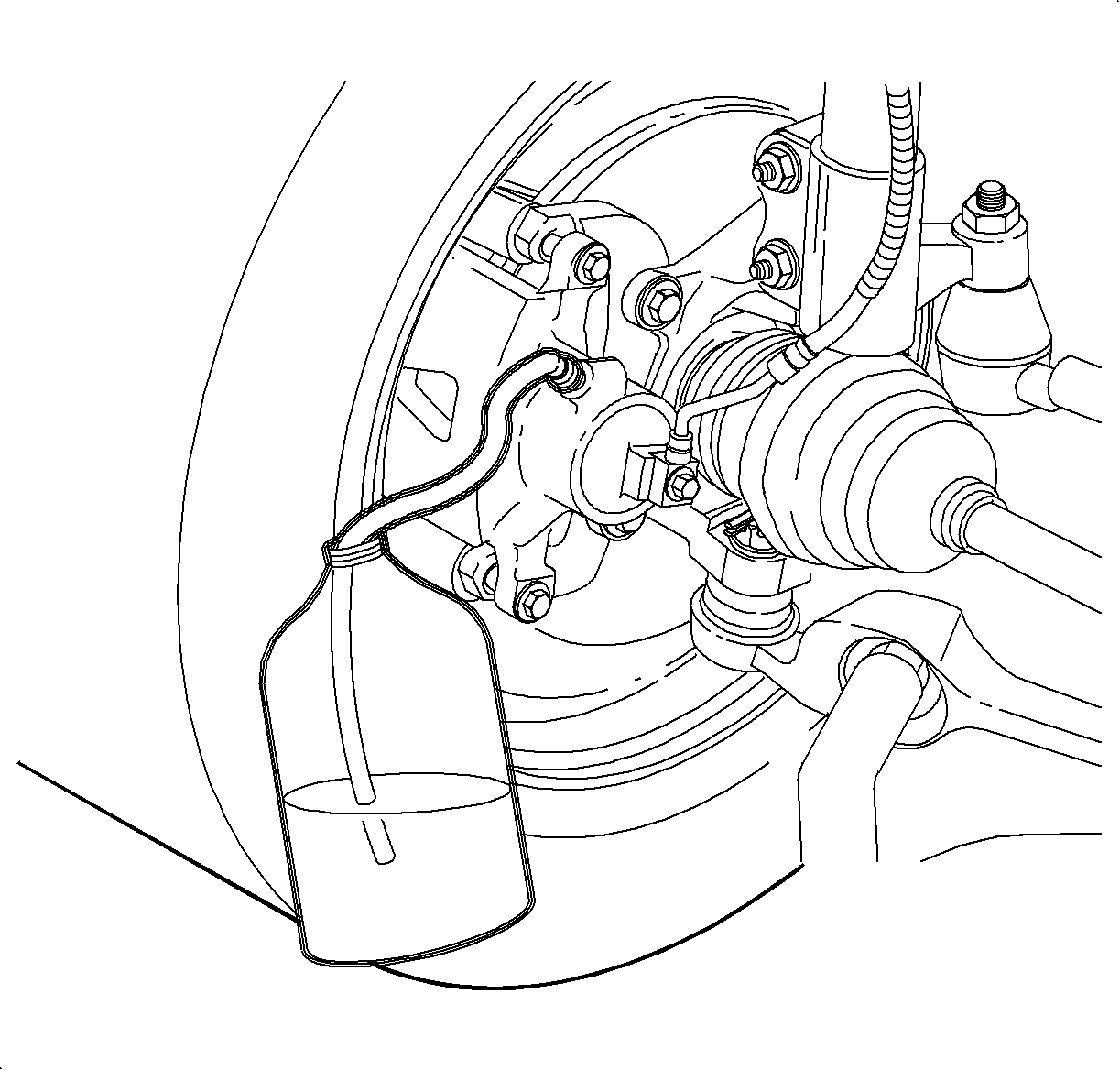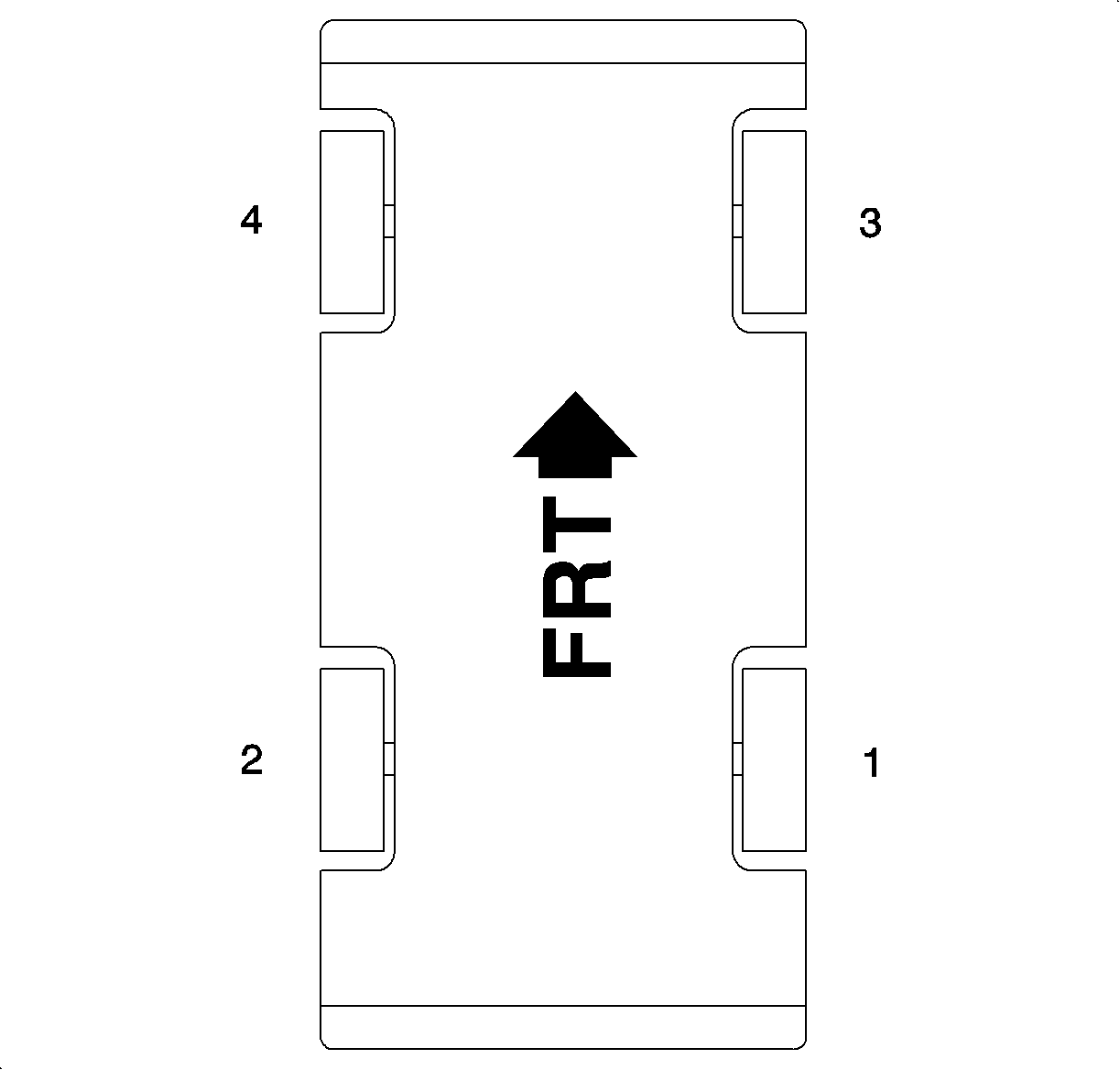Antilock Brake System Automated Bleed Procedure With Pressure Bleeder
Tools Required
| • | Delco Supreme II (or equivalent) DOT 3 Brake Fluid |
| • | Plastic Bleeder Bottle (equipped with hose to recover brake fluid) |
The automated brake bleed procedure is used on DBC7 ABS systems. This procedure
uses a scan tool to cycle the solenoid valves and run the pump in order to purge
air from the secondary circuits. The automated bleed procedure opens the secondary
circuits, then allows trapped air in the brake pressure modulator valve (BPMV) to
flow outwards to the individual corners, where the air is purged from the system.
Important: The automated brake bleed procedure is required when one of the following has
occurred:
| • | Valve assembly removal or replacement. |
| • | Manual bleed of calipers and wheel cylinders does not obtain desired pedal
height or travel. |
| • | Master cylinder removal or replacement. |
| • | Extreme loss of brake fluid. |
| • | Air ingestion is suspected. |
Important: Pressure bleeding is the preferred method of brake system bleeding and should
be used whenever possible. If a pressure bleeder is not available, a manual pedal
method can be used with the aid of an assistant. Refer to Automatic Bleed Procedure
(Without Pressure Bleeder).
Preliminary Inspection and Setup Procedure
- Inspect the battery for full charge. Charge the battery or repair the
charging system if the battery not fully charged.
- Connect a scan tool to DLC connector. Check and repair the current or
history DTCs prior to performing the ABS bleed procedure.
- Inspect for visual damage or leaks. Repair as needed.
Important: Use only DOT 3 brake fluid. Brake fluid is corrosive. Take care not to
allow brake fluid to contact any painted surfaces. Wipe off and clean painted surface
immediately if contact is made.
- Fill the master cylinder reservoir with clean brake fluid. Keep the reservoir
at least half full and SA9150BR
on during the bleed procedure.
- Connect the J 29532
(or equivalent) and pressurize to 241 kPa (35 psi).
- Turn the ignition switch to RUN, with the engine OFF.
- Raise the vehicle on a suitable support.
- Connect a scan tool and establish communication with ABS system by following
these steps:
| 8.2. | Select the appropriate model year |
| 8.3. | Select SATURN (not passenger car) |
The ABS braking is not available when ABS/TCS lamps are illuminated statement
will appear on screen.
| 8.7. | Select SPECIAL FUNCTIONS |
| 8.8. | Select AUTOMATED BLEED |
The connect required brake bleed equipment statement will appear on screen.
Automatic Bleed Procedure (With Pressure Bleeder)

- With the pressure bleeder at 241 kPa (35 psi) and the bleeder
screws in the closed position, select CONTINUE to start the bleed procedure.
The first part of the automated bleed procedure will cycle the pump for 60 seconds.
After cycling the pump, the scan tool will go into a cool-down mode for 180 seconds,
a 3 minute timer will be displayed. The automated bleed procedure will not
continue until the timer has expired, and it cannot be overridden.

Important: Fill the master cylinder reservoir with clean brake fluid. Keep the reservoir
at least half full and SA9150BR
on during bleed procedure.
- The scan tool will instruct to open the right rear bleeder screw first. Once
the bleeder screw is opened, press START. The scan tool will then cycle both respective
release valves and pump motor for 60 seconds. Once scan tool is done cycling
the designated brake corner, close the bleeder screw prior to moving on the next
corner.

Important: The pressure bleeder should still be attached with 241 kPa (35 psi).
- Repeat step 2 with the scan tool for the remaining brake corners in the
following order:
- Next, the scan tool will instruct to open each bleeder screw an additional
20 seconds, starting again with the right rear corner. This will allow any
remaining air to purge out of the system.
Open the bleeder screw and press CONTINUE. Once the scan tool is done cycling
designated brake corner, close the bleeder screw prior to moving on to the next
corner. Follow same procedure for the remaining brake corners, left rear, right front,
left front.
Once all four bleeder screws have been opened and closed, the scan tool will
display PROCEDURE COMPLETE.
- Once all four bleeder screws have been opened and closed the scan tool
will display PROCEDURE COMPLETE.
Notice: Refer to Fastener Notice in the Preface section.
- Torque the bleeder screws.
Tighten
| • | Tighten the front bleeder screws to 11 N·m (97 lb in). |
| • | Tighten the rear bleeder screws to 7.5 N·m (66 lb in). |
- Release the pressure from the pressure bleeder and disconnect from the
vehicle.
- Depress the brake pedal to gage pedal height and travel. It may be necessary
to repeat steps 1-7 if the pedal feel and travel are unacceptable.
- Remove the scan tool from the DLC connector.
- Lower the vehicle.
- Inspect the brake fluid level in the steering cylinder reservoir, fill
as needed with DOT 3 brake fluid.
- Road test the vehicle to verify the proper brake pedal height and travel.
Antilock Brake System Automated Bleed Procedure Without Pressure Bleeder
Tools Required
| • | Delco Supreme II (or equivalent) DOT 3 Brake Fluid |
| • | Plastic Bleeder Bottle (equipped with hose to recover brake fluid) |
Important: If a pressure bleeder is not available, a manual pedal method can be used with
the aid of an assistant. The manual pedal method will consist of the assistant opening
and closing bleeder screws or actuating the brake pedal. The manual pedal method will
still require the use of a Scan tool to properly bleed the brake system.
The alternate automated brake bleed procedure is used on DBC7 ABS systems. This
procedure uses a Scan tool to cycle the solenoid valves and run the pump in order
to purge air from the secondary circuits. The automated bleed procedure opens the
secondary circuits, then allows trapped air in the brake pressure modulator valve
(BPMV) to flow outwards to the individual corners, where the air is purged from
the system.
Important: The alternate automated brake bleed procedure is required when one of the following
has occurred:
| • | Valve assembly removal or replacement |
| • | Manual bleed of calipers and wheel cylinders does not obtain desired pedal
height or travel |
| • | Master cylinder removal or replacement |
| • | Extreme loss of brake fluid |
| • | Air ingestion is suspected. |
Preliminary Inspection and Setup Procedure
- Inspect the battery for full charge. Charge the battery or repair the
charging system if the battery is not fully charged.
- Connect a scan tool to DLC connector. Check and repair current or history
DTCs prior to performing any brake system bleeding.
- Inspect for visual damage or leaks, repair as needed.
- Fill the master cylinder reservoir with clean brake fluid. Keep the reservoir
at least half full during the entire bleed procedure.
Important: Use only DOT 3 brake fluid. Brake fluid is corrosive. Take care not to
allow brake fluid to contact any painted surfaces. Wipe off and clean painted surface
immediately if contact is made.
- Turn the ignition switch to RUN, with the engine OFF.
- Raise the vehicle on a suitable support.
- Connect the scan tool and establish communication with ABS system by following
these steps:
| 7.2. | Select the appropriate model year |
| 7.3. | Select SATURN (not passenger car) |
The ABS braking is not available when ABS/TCS lamps are illuminated statement
will appear on the screen.
| 7.7. | Select SPECIAL FUNCTIONS |
| 7.8. | Select AUTOMATED BLEED |
The Connect Required Brake Bleed Equipment statement will appear the on screen.
Disregard the statement for this alternate automated bleed procedure.
Alternate Automated Bleed Procedure
- With the bleeder screws in the closed position, Select CONTINUE to start
the bleed procedure.
The first part of the automated bleed procedure will cycle the pump for 60 seconds.
After cycling the pump, the scan tool will go into a cool-down mode for 180 seconds,
a 3 minute timer will be displayed. The automated bleed procedure will not
continue until the timer has expired, and it cannot be overridden.
Important: For the following steps, the assistant should be applying and holding the brake
pedal, or opening and closing the designated bleeder screw when appropriate.
- The scan tool will instruct to open the right rear bleeder screw first.
| 2.1. | Before starting the bleed procedure, assistant should slowly stroke, apply,
and hold the brake pedal. |
| 2.2. | Once the brake pedal is in a held position, press START on the scan tool
and open the bleeder screw simultaneously. |
| 2.3. | When the brake pedal reaches the floor, close the bleeder screw. The
assistant can now release the brake pedal. |
| 2.4. | The assistant should again stroke, apply, and hold the brake pedal. |
| 2.5. | Open the bleeder screw until the brake pedal reaches the floor. Then close
the bleeder screw. |
| 2.6. | Repeat this procedure as many times as possible during the scan tool timed
program or until all air is removed. |
| 2.7. | Once the scan tool is done cycling the designated brake corner, ensure
that the bleeder screw is closed prior to moving on to the next corner. |

- Repeat step 2 with the scan tool for the remaining brake corners in the
following order:
Important: The assistant should continue to apply and hold the brake pedal, or open and
close the designated bleeder screw when appropriate.
- Next, the scan tool will instruct to open each bleeder screw an additional 20 seconds,
starting again with the right rear corner. This will allow any remaining air to
purge out of the system.
| 4.1. | Before starting bleed procedure, assistant should slowly stroke, apply,
and hold the brake pedal. |
| 4.2. | Once the brake pedal is in a held position, press START on the scan tool
and open the bleeder screw simultaneously. |
| 4.3. | When the brake pedal reaches the floor, close the bleeder screw. The assistant
can now release the brake pedal. |
| 4.4. | The assistant should again stroke, apply, and hold the brake pedal. |
| 4.5. | Open the bleeder screw until the brake pedal reaches the floor. Then close
the bleeder screw. |
| 4.6. | Repeat this procedure as many times as possible during the scan tool timed
program or until all air is removed. |
| 4.7. | Once scan tool is done cycling the designated brake corner, ensure that
the bleeder screw is closed prior to moving on to the next corner. |
- Once all four bleeder screws have been opened and closed the scan tool
will display PROCEDURE COMPLETE. The assistant is no longer needed.
Notice: Refer to Fastener Notice in the Preface section.
- Torque the bleeder screws.
Tighten
| • | Tighten the front bleeder screws to 11 N·m (97 lb in). |
| • | Tighten the rear bleeder screws to 7.5 N·m (66 lb in). |
- Depress the brake pedal to gage pedal height and travel. It may be necessary
to repeat steps 1-6 if pedal feel and travel are unacceptable.
- Remove the scan tool from DLC.
- Lower the vehicle.
- Inspect the brake fluid level in the master cylinder reservoir, fill as
needed with DOT 3 brake fluid.
- Road test the vehicle to verify proper brake pedal height and travel.




